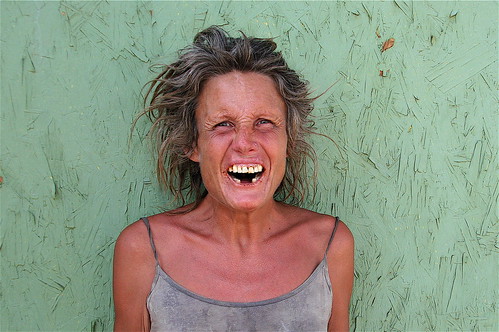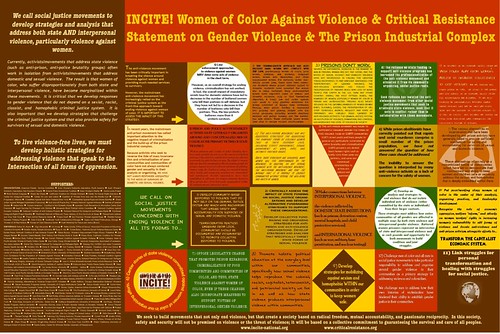Women in Prison: A Fact Sheet
The Issue: Sentencing and the War on Drugs
The Department of Justice found that women were over represented among low level drug offenders who were non-violent, had minimal or no prior criminal history, and were not principal figures in criminal organizations or activities, but nevertheless received sentences similar to “high level” drug offenders under the mandatory sentencing policies. From 1986 to 1996 the number of women sentenced to state prison for drug crimes increased ten-fold. Nationally one in three women in prison and one in four women in jail are incarcerated for violating a drug law. (Department of Justice, Bureau of Justice Statistics Prisoners in 1997)
· According to The Boston Globe, "nearly 26% of the nearly 2000 men and women crowding Massachusetts
· From 1986 to 1996, the number of women sentenced to state prison for drug crimes increased from 2,370 to 23,700. (Bureau of Justice Statistics, Washington DC Prisoners in 1997)
· In 1986, 12.0% of women in prison were drug offenders. In 1991, 32.8% of women in prison were incarcerated for drug offenses. (Women in Prison, Survey of State Prison Inmates, 1991. US Department of Justice, March 1994, NCJ 145321)
The Issue: Sexual Assault and Misconduct Against Women in Prison
The imbalance of power between inmates and guards involves the use of direct physical force and indirect force based on the prisoners’ total dependency on officers for basic necessities and the guards’ ability to withhold privileges. Some women are coerced into sex for favors such as extra
food or personal hygiene products, or to avoid punishment.
· Powerlessness and Humiliation
There are 148,200 women in state and federal prisons. In federal women’s correctional facilities, 70% of guards are male. Records show correctional officials have subjected female inmates to rape, other sexual assault, sexual extortion, and groping during body searches. Male correctional officials watch women undressing, in the shower or the toilet. Male correctional officials retaliate, often brutally, against female inmates who complain about sexual assault and harassment
· Retaliation and Fear
In many states guards have access to and are encouraged to review the inmates’ personal history files (this includes any record of complaints against themselves or other prison authorities). Guards threaten the prisoner’s children and visitation rights as a means of silencing the women. Guards issue rule infraction tickets, which extend the woman’s stay in prison if she speaks out. Prisoners who complain are frequently placed in administration segregation.
· Impunity
Ineffective formal procedures, legislation and reporting capacity within US jails and prisons account for much of the ongoing sexual abuse of women. In 1997, according to the US
The Issue: Medical Neglect of Women in US Prisons
Women are denied essential medical resources and treatments, especially during times of pregnancy and/or chronic and degenerative diseases.
· Failure to refer seriously ill inmates for treatment and delays in treatment
Women inmates suffering from treatable diseases such as asthma, diabetes, sickle cell anemia, cancer, late-term miscarriages, and seizures have little or no access to medical attention, sometimes resulting in permanent injury or death. Instances of failure to deliver life-saving drugs for inmates with HIV/AIDS have also been noted.
· Lack of qualified personnel and resources and use of non-medical staff
There is too few staff to meet physical and mental health needs. This often results in long delays in obtaining medical attention; disrupted and poor quality treatment causing physical deterioration of prisoners with chronic and degenerative diseases, like cancer; overmedication of prisoners with psychotropic drugs; and lack of mental health treatment. The use of non-medical staff to screen requests for treatment is also common.
· Charges for medical attention
In violation of international standards, many prisons/jails charge inmates for medical attention, arguing that the charge deters prisoners from seeking medical attention for minor matters or because they want to avoid work. In some supermaximum prisons, where prisoners cannot work at all, the US
· Inadequate Reproductive Health Care
In 1994, the National Institute of Corrections stated that provision of gynecological services for women in prison is inadequate. Only half of the state prison systems surveyed offer female-specific services such as mammograms and Pap smears, and often entail a long wait to be seen.
· Shackling During Pregnancy
Shackling of all prisoners, including pregnant prisoners, is standard policy in federal prisons and in the US
· Lack of treatment for substance abuse
The gap between services available and treatment needs continues to grow. The number of prisoners with histories of drug abuse is growing, but the proportion of prisoners receiving treatment declined from 40% in 1991 to 18% in 1997.
· Lack of Adequate or Appropriate Mental Health Services
The Issue: Discrimination Based On Gender, Race and Sexual Orientation
The growth in incarceration has had its greatest impact on minorities, particularly African Americans. Women are most vulnerable to different forms of discrimination, including sexual harrasment or abuse. Women that do not fit the “norm”, such as lesbians, are more succeptable to torture and abuse.
Discrimination Based on Race:
· Over a five-year period, the incarceration rate of African American women increased by 828%. (NAACP LDF Equal Justice Spring 1998.) An African American woman is eight times more likely than a European American woman is to be imprisoned. African American women make up nearly half of the nation’s female prison population, with most serving sentences for nonviolent drug or property related offenses.
· Latina
· State and federal laws mandate minimum sentences for all drug offenders. This eliminates the option for judges to refer first time non-violent offenders to drug treatment, counseling and education programs. The racial disparity revealed by the crack v. powder cocaine sentences insures that more African American women will land in prison.
Although 2/3 of crack users are white or Hispanic, defendants convicted of crack cocaine possession in 1994 were 84.5% African American. Crack is the only drug that carries a mandatory prison sentence for first time possession in the federal system.
Discrimination Based On Sexual Orientation:
· Human Rights Watch has documented categories of women who are likely targets for sexual abuse. Perceived or actual sexual orientation is one of four categories that make a female prisoner a more likely target for sexual abuse, as well as a target for retaliation when she reports that abuse.
· If a woman is a lesbian, her criminal defense becomes more challenging. Jurors in the US
· The case of Robin Lucas depicts how sexual identity may subject a woman to further abuse or torture by a guard. She was placed in a men’s prison where male guards allowed male inmates to rape her. The male guards taunted her about her same sex relationship, saying to her “maybe we can change your mind”.
For more information on issues affecting women in prison and other women’s human rights issues, please visit the Women’s Human Rights Program website at www.amnestyusa.org/women or contact us at AIUSA 5 Penn Plaza-16th floor, New York , NY 10001























No comments:
Post a Comment